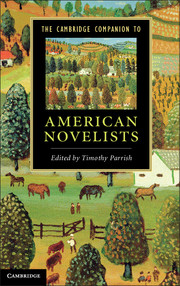Book contents
- Frontmatter
- Contents
- Contributors
- Introduction
- 1 James Fenimore Cooper
- 2 Nathaniel Hawthorne
- 3 Herman Melville
- 4 Harriet Beecher Stowe
- 5 Mark Twain
- 6 Henry James
- 7 Edith Wharton
- 8 Theodore Dreiser
- 9 Willa Cather
- 10 F. Scott Fitzgerald
- 11 Ernest Hemingway
- 12 William Faulkner
- 13 Henry Roth
- 14 Djuna Barnes
- 15 Zora Neale Hurston
- 16 Richard Wright
- 17 Raymond Chandler
- 18 Ralph Ellison
- 19 J. D. Salinger
- 20 Patricia Highsmith
- 21 Vladimir Nabokov
- 22 Jack Kerouac
- 23 Saul Bellow
- 24 Kurt Vonnegut
- 25 John Updike
- 26 Thomas Pynchon
- 27 Toni Morrison
- 28 Philip Roth
- 29 Don DeLillo
- 30 Cormac McCarthy
- Guide to Further Reading
- Index
- References
12 - William Faulkner
Published online by Cambridge University Press: 05 December 2012
- Frontmatter
- Contents
- Contributors
- Introduction
- 1 James Fenimore Cooper
- 2 Nathaniel Hawthorne
- 3 Herman Melville
- 4 Harriet Beecher Stowe
- 5 Mark Twain
- 6 Henry James
- 7 Edith Wharton
- 8 Theodore Dreiser
- 9 Willa Cather
- 10 F. Scott Fitzgerald
- 11 Ernest Hemingway
- 12 William Faulkner
- 13 Henry Roth
- 14 Djuna Barnes
- 15 Zora Neale Hurston
- 16 Richard Wright
- 17 Raymond Chandler
- 18 Ralph Ellison
- 19 J. D. Salinger
- 20 Patricia Highsmith
- 21 Vladimir Nabokov
- 22 Jack Kerouac
- 23 Saul Bellow
- 24 Kurt Vonnegut
- 25 John Updike
- 26 Thomas Pynchon
- 27 Toni Morrison
- 28 Philip Roth
- 29 Don DeLillo
- 30 Cormac McCarthy
- Guide to Further Reading
- Index
- References
Summary
Readers seduced by the power of William Faulkner’s rendering of the South may think that he invented the region, but it was already – and had been for centuries – a heavily written-about place. To understand Faulkner’s contribution to American fiction, we need to consider the background of southern attitudes that developed and took hold in the half-century following the Civil War. During this period a number of southern writers transformed, retrospectively, the meaning of the Civil War – from a history of defeat to the myth of the Lost Cause. In the writings of Thomas Dixon (The Clansman, 1905) and Thomas Nelson Page (The Old Dominion, 1908), for example, the South “became” a place of aristocratic gallantry, a preserve of Old World culture. Joel Chandler Harris’s Uncle Remus stories, published throughout the first two decades of the twentieth century, softened the portrait of race relations as well, giving it a picturesque, fit-for-children charm. The South’s humiliation of 1861–5 was thus reconfigured to read as tragic despoliation, entailing the release of lawless black beasts upon the American scene. D. W. Griffith’s immensely popular film version of Dixon’s The Clansman – Birth of a Nation (1915) – crystallizes this reactionary vision of the South. That Faulkner’s first-grade teacher would give him a copy of The Clansman to express her appreciation of the boy’s promising talents suggests how far the myth had penetrated into the precincts of normative southern self-awareness (Blotner 1: 94)
Faulkner inherited such a notion of his region – his great-grandfather had been a flamboyant defender of the Old South during and after the Civil War – and vestiges of the myth recur as a sort of default dimension of his weaker writings. But his great work – the work that reveals Faulkner as Faulkner – sees strenuously through this myth. Indeed, the act of seeing through this myth enables Faulkner to become the most powerful white novelist of race relations this country has yet produced. No reader of his work before Light in August (1932), however, could have predicted such a turn in his career.
- Type
- Chapter
- Information
- The Cambridge Companion to American Novelists , pp. 114 - 124Publisher: Cambridge University PressPrint publication year: 2012
References
- 14
- Cited by

